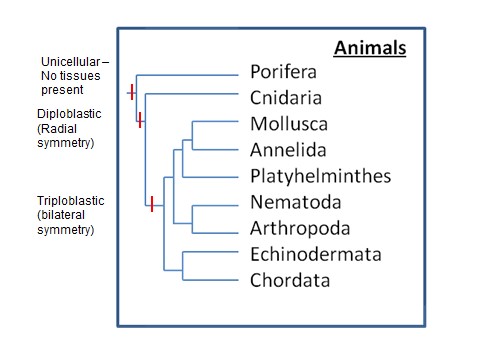Classification
Cassiopea xamachana are essentially upside-down jellyfish. In more scientific terms, they are Cnidarians (Todd et al. 2006). This means that they, like us, are part of the kingdom Animalia. Cassiopea come in six different species that are all invertebrates (Holland et al. 2004). These six species are grouped in several different ways. One way to group them is all under one species- Cassiopea andromeda (Holland et al. 2004). Others characterize them as three species, including andromeda, frondosa, and xamachana (Holland et al. 2004). The third proposed way is to say they are frondosa and three other species. These three other species are different genotypically, but similar phenotypically (Holland et al. 2004).
Classification of the jellyfish species is based on whether or not they are genetically different enough. To be considered a different species, the jellyfish must be 10-20% different on a genetic level; this is what makes the moon jellyfish and upside-down jellyfish separate species (Holland et al. 2004). Another characteristic of Cassiopea that helps to classify them is their larvae and various spawning techniques (Niggl et al. 2009 and Thornhill et al. 2006), as mentioned on the interaction portion of this webpage. Another way that one may choose to classify them is to call them heterotrophs, as they do not make their own food (Todd et al. 2006, Thornhill et al. 2006, McGill et al. 179-180, Santhanakrishnan et al. 2012). Cassiopea collect organic matter and they also rely on dinoflagellates to provide them with most of their nutrients (McGill et al. 180).
Cassiopea
are diploblastic with radial symmetry. This is their main
synapomorphy as part of the Cnidarian phylum. Cassiopea are
also members of the order Rhizostomeae. Another important
synapomorphy for the Cnidarians is the presence of oral arms
(Santhanakrishnan et al. 2012). Small oral arms and a few
mouths help these jellyfish to stand out from other
Scyphozoa with larger arms and one mouth (Santhanakrishnan
et al. 2012). While they possess these unique features, they
still have a bell and a manubrium area. This manubrium is a
form of gut before the mesoderm was derived
(Santhanakrishnan et al. 2012). An important reason to be
able to classify this species is because it is often
considered an invasive species that can be transported via
boats (Holland et al. 2004).

Domain: Eukarya
Major Clade: Opisthokonta
Kingdom: Animals
Phylum: Cnidaria

